Sculpture on the Move: A Century of Rodin at The Met

Four boys viewing a monumental plaster cast of Rodin's The Thinker at The Met in 1913. Visible at rear is the small, original-sized bronze cast in The Met collection: The Thinker (modeled probably 1880, cast ca. 1910).
«We tend not to think of sculpture as mobile; its monumentality lends it a visual sense of permanence. Within museum settings, however, this is hardly the case. Sculptures are moved frequently, most often to accommodate new acquisitions or express different visual relationships. The art of the French sculptor Auguste Rodin (1840–1917) has had a long and peripatetic history at The Met. Prior to its current installation in the newly refurbished B. Gerald Cantor Sculpture Gallery, The Met's Rodin collection inhabited several different spaces within the Museum. By reflecting on this history, we stand to gain insight into the sculptor's reception and legacy in the United States, as well as the Museum's evolving modes of sculptural display.»
The "Little Rodin Gallery"
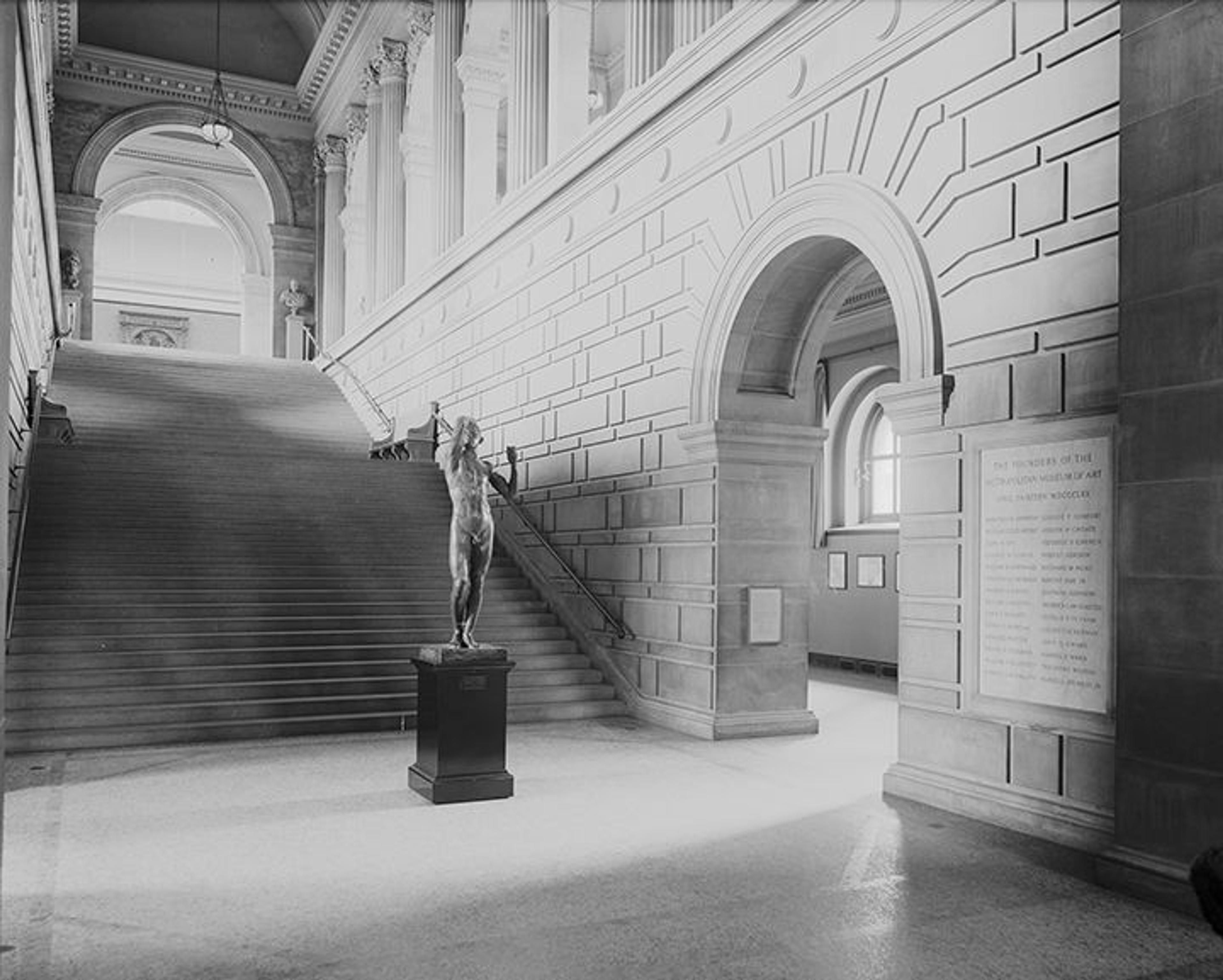
The Age of Bronze (L'Age d'airain) (modeled 1876, cast ca. 1906) greets visitors at the base of the Grand Staircase, photographed in 1919, just left of the arched entrance to the Rodin installation, Wing D, Room 1 (Great Hall).
The Rodin gallery of 1912 was the Museum's first installation devoted exclusively to the work of a living artist. Over 30 of his sculptures and seven of his drawings were exhibited in a corridor off of the Great Hall (today, gallery 301). As the first major presentation of Rodin's sculptures within an American museum, the "little Rodin gallery," as one newspaper called it, signified at once the sculptor's newfound preeminence in the United States and The Met's embrace of contemporary art.[1]
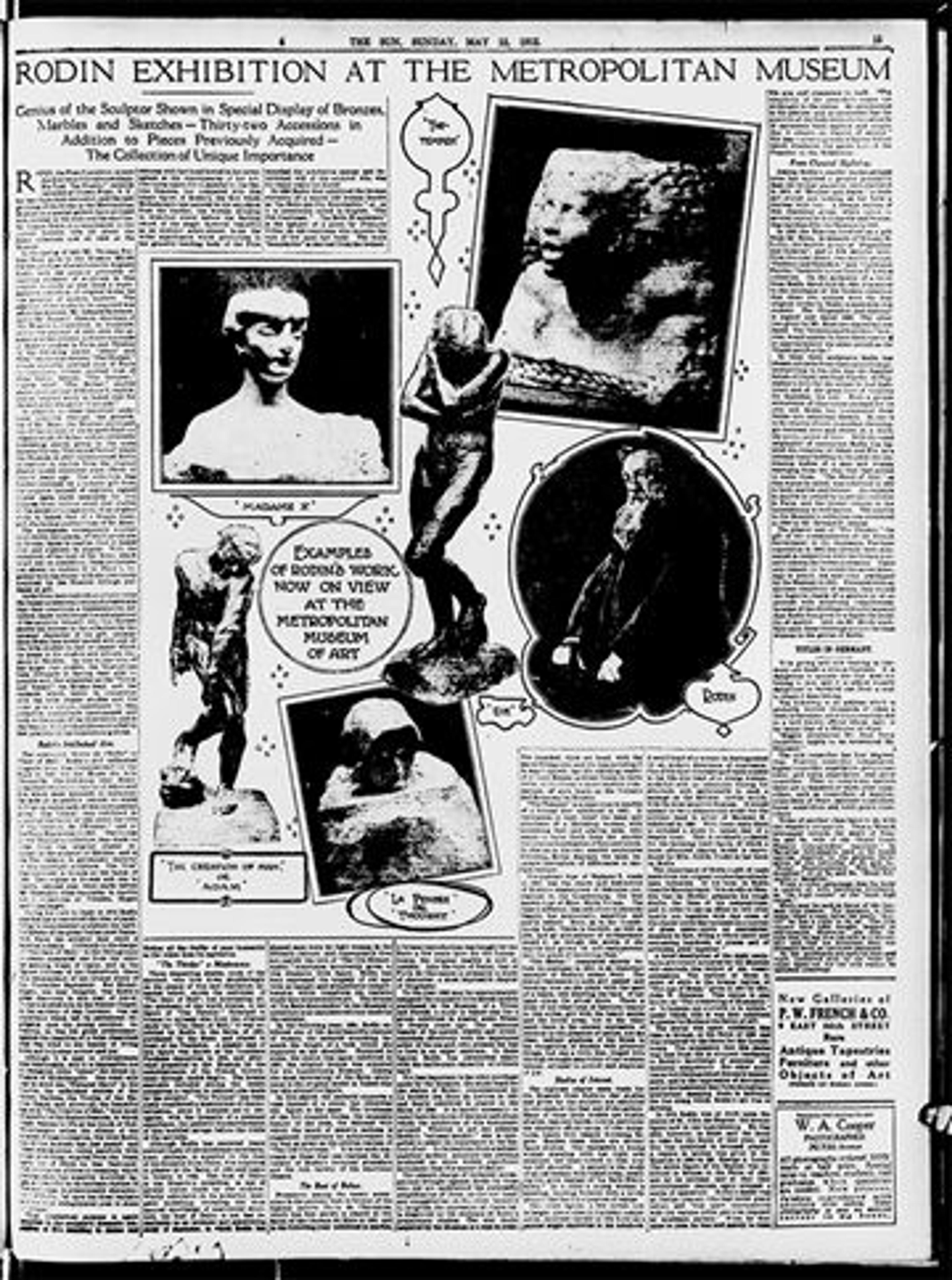
Right: "Rodin Exhibition at The Metropolitan Museum," Sun, May 12, 1912.
Previously, the Museum had prioritized the purchase of ancient sculpture and bronze and plaster casts. This changed, however, in January 1906 when the American sculptor Daniel Chester French, chairman of The Met's Committee on Sculpture, submitted a report to the Board of Trustees recommending the purchase of "the best works of modern sculpture," including "the work of living artists" and that of Rodin in particular.[2] Just four years later, the gift of $25,000 from the financier, philanthropist, and collector Thomas Fortune Ryan for the purchase of works by Rodin enabled the committee to realize its goal.
The opening of the 1912 gallery was well documented in newspapers and a Museum publication written by assistant curator of Decorative Arts (and later head of The Met Cloisters) Joseph Breck, which emphasized the new acquisitions' educational significance. The purpose of the Rodin installation, he explained, was to enable "students of sculpture in this country to study at first hand a representative collection of original works by this greatest of modern masters."[3]

Two views of The Metropolitan Museum of Art, Wing D, 1st Floor, Room 13. Left: View of the Rodin gallery, looking west into Wing A, with Adam (modeled 1880 or 1881, cast 1910) and Pygmalion and Galatea (modeled 1889, carved ca. 1908–9). Right: View of the Rodin gallery, looking east into Wing D, Room 1, with The Hand of God (modeled ca. 1896–1902, carved ca. 1907). Both photographed 1912
However, the Museum's presentation of Rodin rejected the informal display then typical of study collections. His works were instead exhibited in a manner that underscored their status as fine art. In his 1906 report, Daniel Chester French emphasized the need to reorganize the Museum's sculptures "so as to present a coherent and orderly collection." To establish this, the committee proposed that, "in the arrangement of the collection, a certain space be set aside expressly for aesthetic purposes, so that separate works may be exhibited with appropriate surroundings tending to enhance their artistic effect. This should be especially the case with new acquisitions."[4]
The 1912 installation exemplified the committee's new approach to the presentation of sculpture as an aesthetic experience. Mixing sculptural media and pedestal heights, the curators established a unifying balance of form across the stately, sun-drenched Rodin gallery.
Rodin on the Move
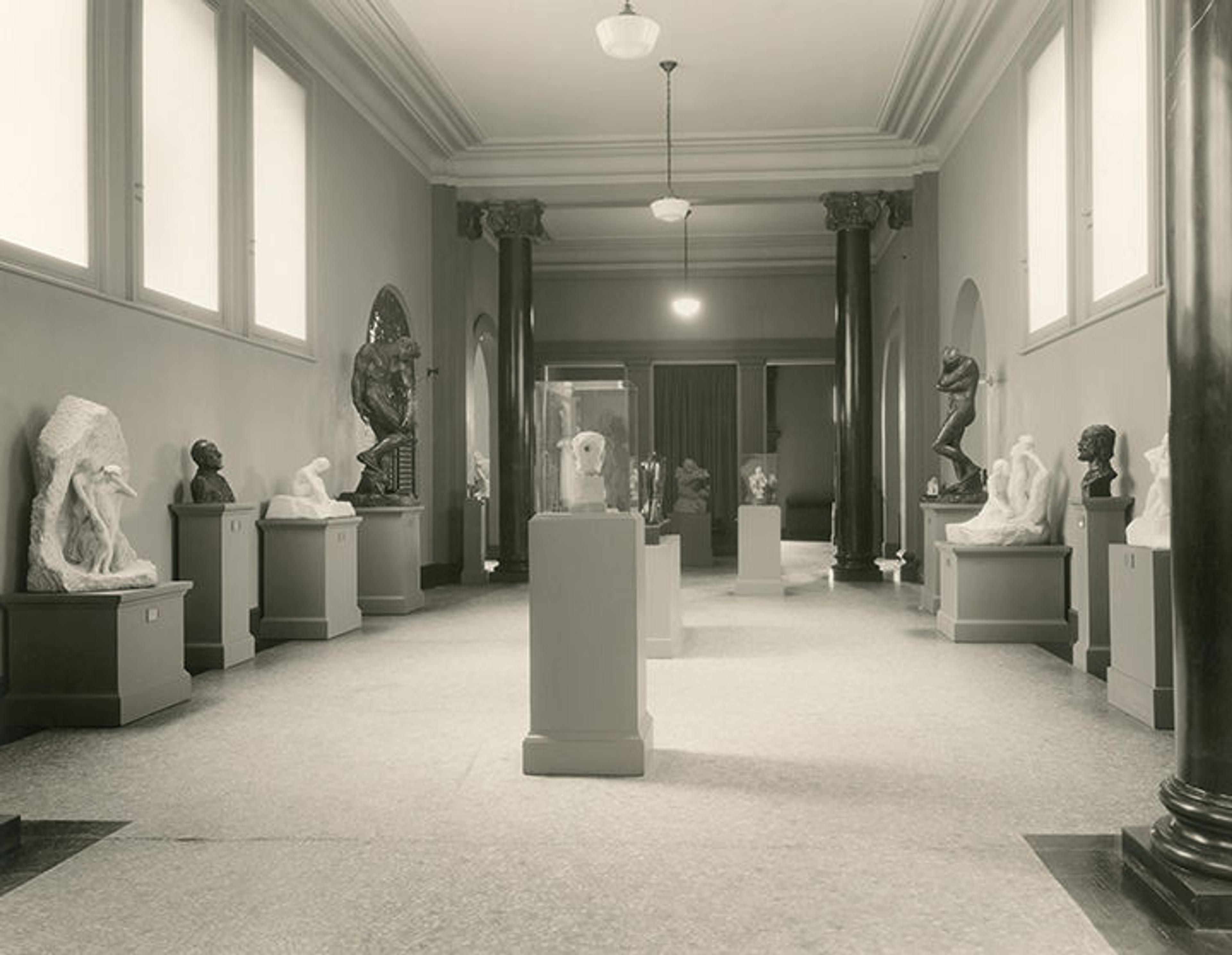
Orpheus and Eurydice (modeled ca. 1887, carved 1893) in Wing B, 1st Floor, Gallery 39: Modern European Sculpture. View looking south. Photographed 1933
The 1912 gallery remained as it was for over a decade, after which the Rodin collection was moved around on the Museum's first floor and eventually integrated into a gallery devoted to modern European sculpture. In the early 1940s, the collection was installed more permanently on the Great Hall Balcony. While this series of movements was part of a larger initiative to relocate sculptures throughout the Museum, the shift of Rodin's work away from the main entrance might also be seen to signal the beginnings of the sculptor's marginalization within the Museum after his artistic reputation had diminished. By midcentury, abstract art represented the avant-garde, and Rodin's figurative sculptures had fallen out of favor.
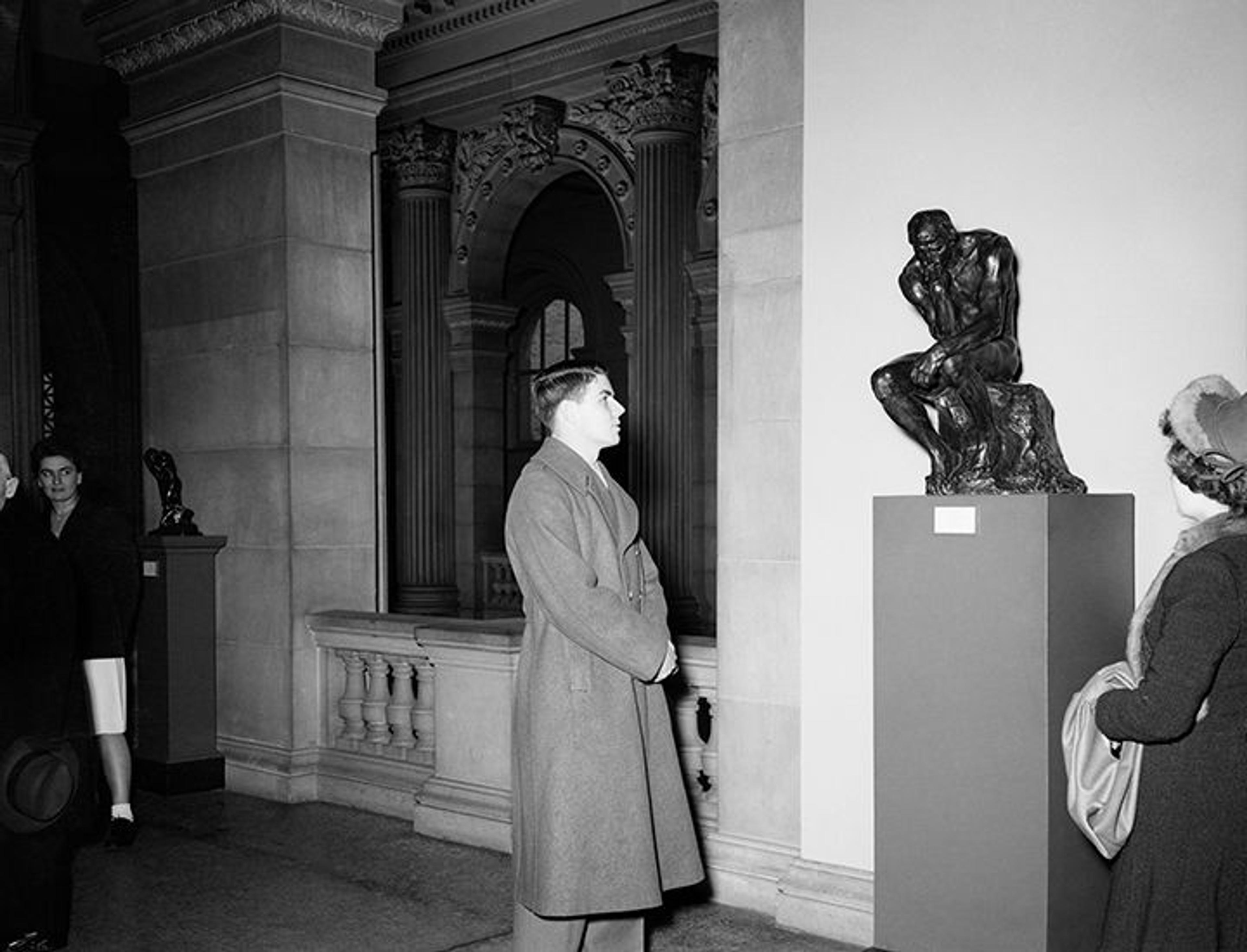
Visitors view The Thinker in the Rodin gallery on the Great Hall Balcony, Wing D, Gallery 8. Photographed 1944
From the sparse documentation of this period regarding the collection's whereabouts, we learn, for example, that sometime in the 1950s the collection was broken up and dispersed throughout the Museum for the first time since its formation. While some works stayed on view on the Great Hall Balcony, others were displayed independently in paintings galleries, and many of Rodin's unfashionable marbles were relegated to the Museum's basement storage, where they remained for several decades.

View of the André Meyer galleries at The Met with sculptures by Rodin and contemporaries, including The Martyr (modeled 1885). Photographed 1982
It was not until the 1980 opening of the André Meyer galleries, built to house The Met's vast collection of 19th-century French art, that the lion's share of the Museum's Rodin collection returned to public view. Within the modern, open-concept, sky-lit galleries was an airy space for sculptural display in which 40 works by Rodin, including many of those exhibited today, were presented alongside 25 compositions by other 19th-century sculptors—among them, Aristide Maillol, Antoine Bourdelle, Jules Dalou, Jean-Baptiste Carpeaux, Antoine-Louis Barye, and Edgar Degas.

Installation view of the exhibition Rodin: The B. Gerald Cantor Collection, including new acquisitions Torso (modeled ca. 1877–78, cast 1979) and The Prayer (modeled 1909, cast 1980). Photographed 1986
Shortly after the opening of the new galleries, the Cantor family financed the completion and endowment of the adjacent southwest wing, which included the Iris and B. Gerald Cantor Exhibition Hall. The wing's 1986 inaugural exhibition, entitled Rodin: The B. Gerald Cantor Collection, appropriately featured sculptures by Rodin from the Cantor's unparalleled private collection of the master's work, and coincided with their gift of an additional 30 sculptures by Rodin to the Museum. The most imposing of these gifts was a new, large-scale bronze cast of The Burghers of Calais, which was installed outdoors alongside other Cantor gifts on the Cantor Roof Garden in 1998.
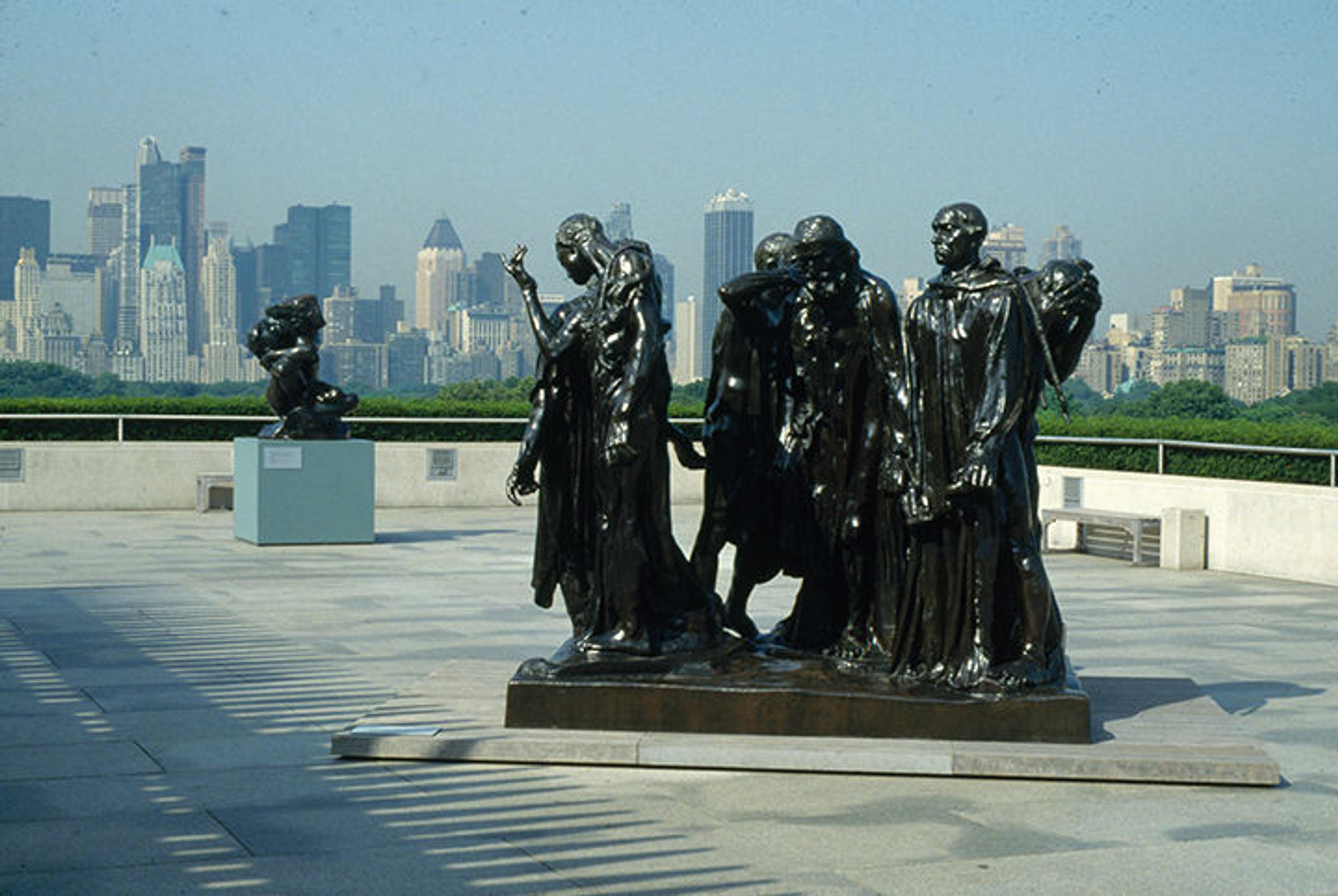
The Burghers of Calais (modeled 1884–95, cast 1985), currently on view in gallery 548, installed on the Iris and B. Gerald Cantor Roof Garden. Photographed 1998.
Many of the Cantor acquisitions would join the permanent display of Rodin's sculptures in the recently renamed B. Gerald Cantor Sculpture Gallery, which was then part of the Meyer wing. By the early 1990s, critical and popular support for the Meyer galleries had waned, and plans were made to transform them from a "sprawling, modern, open space to a series of traditional, classically styled rooms," more suitable, it was thought, for the display of 19th-century art.
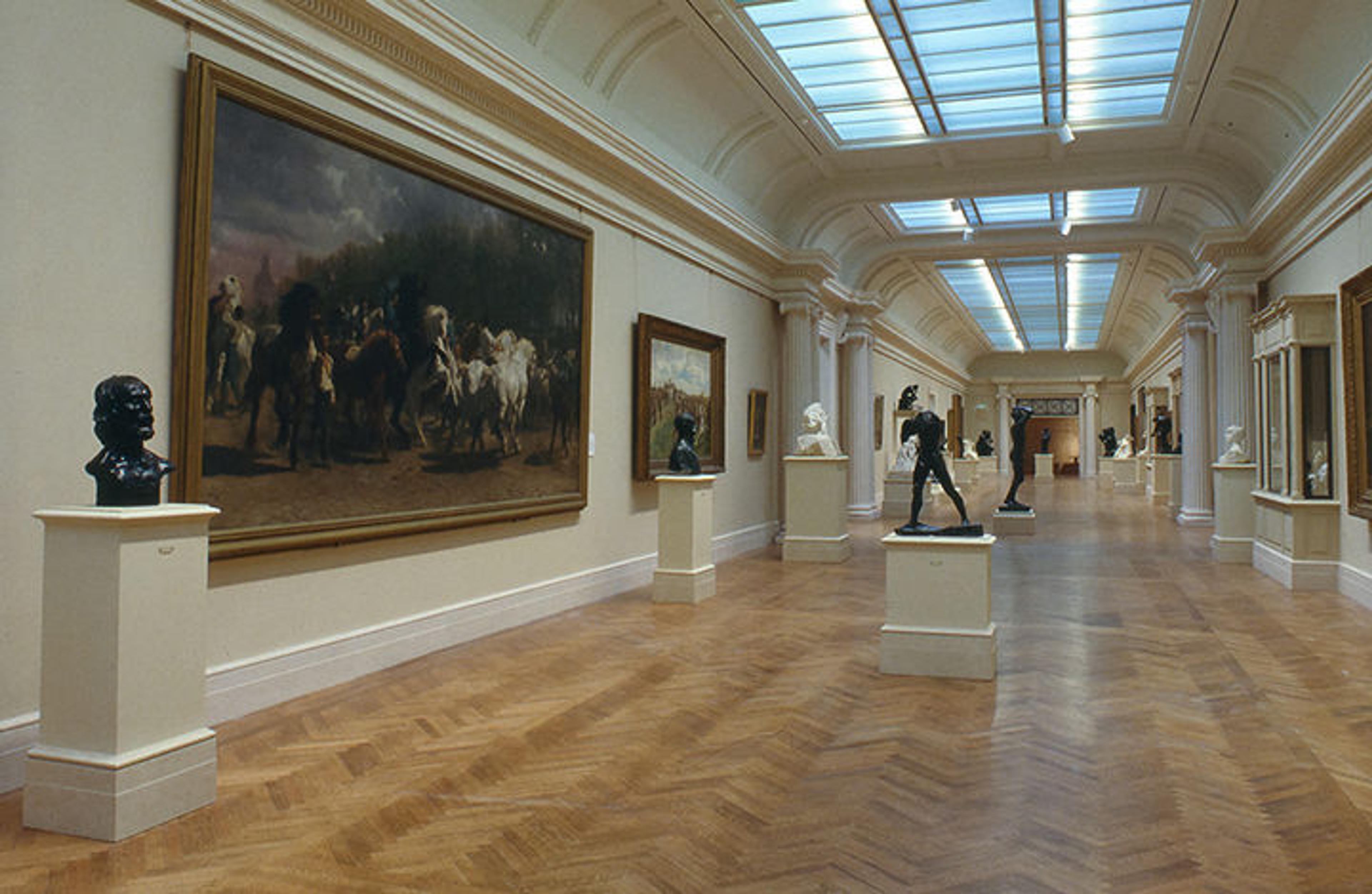
The B. Gerald Cantor Sculpture Gallery, including St. John the Baptist (modeled ca. 1878, cast ca. 1888), Rosa Bonheur's The Horse Fair (1852–55), and The Walking Man (L'homme qui march) (modeled before 1900, cast before 1914). Photographed 1993
Under the direction of former curator Gary Tinterow, the B. Gerald Cantor Sculpture Gallery was converted into a Beaux-Arts-inspired hall, modeled in the spirit of the Louvre's Grande Galerie, that would "house sculpture and large Salon paintings and serve as a foyer for the rest of the new galleries."[5] In this space, a mixed selection of sculpture by Rodin and his 19th-century contemporaries, such as Barye and Antoine-Augustin Préault, were shown alongside paintings from the period.
Rodin at The Met Today
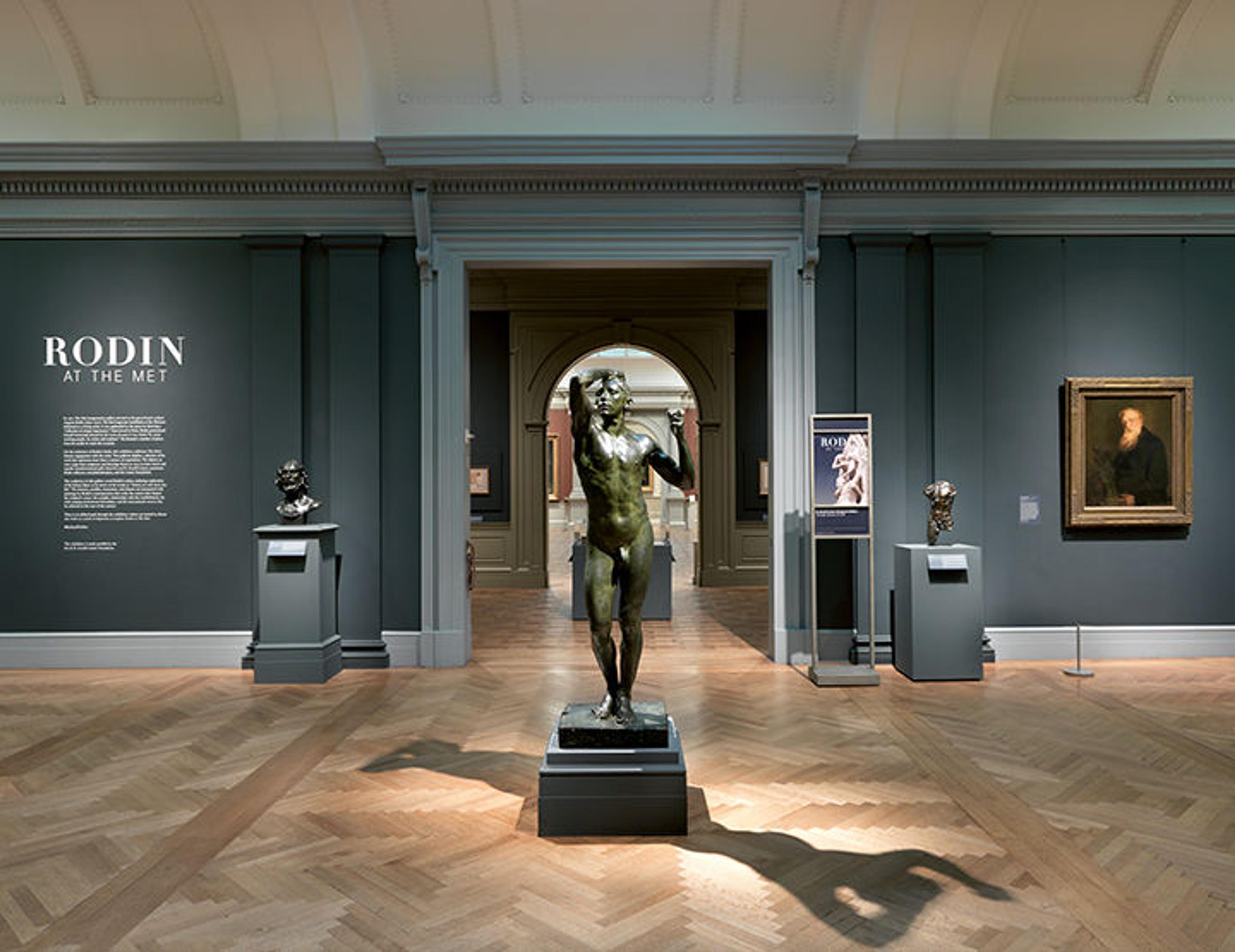
Installation view of Rodin at The Met. At center is The Age of Bronze (L'Age d'airain), which greeted visitors in the Great Hall in 1912. The painting at far right is Robert MacCameron's Auguste Rodin (1910). Photographed 2017
In some ways, the 2017 reinstallation of this gallery, occasioned by the centenary of Rodin's death, marked a return to the 1912 display: the recently closed Rodin at The Met exhibition (which was on view from September 16, 2017, through February 4, 2018) was, above all, a beautiful gallery that highlighted the breadth and depth of The Met's Rodin collection and encouraged aesthetic contemplation through subtle lighting, fresh paint, and a harmonious arrangement. It was the first instance since 1912 that a selection of Rodin's drawings were displayed along with his sculptures in the Museum.

Left: Installation view of Rodin at The Met. Photographed 2017
At the same time, the installation offered a new perspective on the Cantor Sculpture Gallery's proposed function as a Salon-style exhibition hall. The juxtaposition of Rodin's sculptures with a thoughtful selection of paintings by his friends, competitors, and contemporaries brought new context and resonance to the works in three dimensions.
Despite the official closure of Rodin at The Met, a broad selection of the artist's sculptures in bronze, marble, terracotta and plaster—drawn entirely from the Museum's permanent collection—will remain on view indefinitely. Rodin's sculptures first entered the collection when the Museum was not yet 50 years old. As The Met approaches its 150th anniversary, the artist continues to be a centerpiece of the institution.
Notes
[1] R. C., "Auguste Rodin at the Metropolitan Museum," New York Tribune, May 19, 1912.
[2] January 15, 1906, Sculpture Committee - Reports and Correspondence, 1906–1907, Office of the Secretary Records, The Metropolitan Museum of Art Archives, New York.
[3] Joseph Breck, The Collection of Sculptures by Auguste Rodin(New York: The Metropolitan Museum of Art, 1913).
[4] January 15, 1906, Sculpture Committee - Reports and Correspondence, 1906–1907, Office of the Secretary Records, The Metropolitan Museum of Art Archives, New York.
[5] Gary Tinterow, The Nineteenth-Century European Paintings and Sculpture Galleries (New York: The Metropolitan Museum of Art, 1993).
Related Content
Read a blog series on Rodin at Now at The Met.
See more digital content related to Rodin at The Met.
Elyse Nelson
Elyse Nelson is a research associate in the Department of European Sculpture and Decorative Arts.